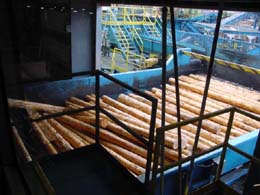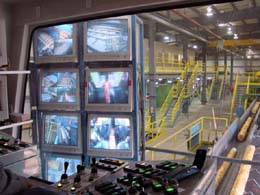This slideshow is based on the Washington Forest Protection Association's educational video, The Life of a Tree: From Seed to Finished Product. Written and curated by David Wilma.
The Life of a Tree: From Seed to Finished Product -- A Slideshow
- By David Wilma
- Posted 5/19/2003
- HistoryLink.org Essay 5691

Settlers in Washington cut trees to clear the land and to sell the logs for cash. Industrial improvements such as steam engines increased the harvest. The bounty of the forest seemed limitless. During the 1930s, the forest products industry shifted away from cutting trees and selling off the land. Timber companies held onto their holdings in the hope that second-growth would renew the resource. But allowing a forest to regrow naturally was slow and inefficient.

In 1941, the Weyerhaeuser Company opened the first tree farm near Montesano, Washington, where seedlings were planted with the intention of harvesting them decades later. Trees became a crop. By the end of the twentieth century, there were 70,000 tree farms in the United States.

Trees in the wild naturally produce seed cones as the result of environmental stress such as drought, disease, or fire. A tree that senses it is dying propagates flowers and seeds to perpetuate the species. In nature, this happens only about every five to seven years.

In a modern nursery, trees selected and cross-bred for their growth potential are grown in orchards. Tree orchards are managed in much the same way as are apple orchards of Washington. Each tree is numbered and every fertilizer and stimulation treatment is planned and recorded. To produce seed cones every 18 months or so, a tree is stressed by scoring the bark with saw cuts.

Seed cones are collected and heated in kilns to release the seeds. The seeds are then cleaned of debris until 99 percent pure. It takes approximately two years of work to produce a 55-pound container of Douglas-fir seeds -- enough for one million seedlings.

In January and February, seeds are sown in individual Styrofoam boxes in container facilities -- immense greenhouses just for trees -- or outdoors. The seeds sprout and grow through the summer and fall with carefully controlled watering and fertilizing. Indoors, foresters can manage the amount of light and the temperature to maximize growth and the number of seedlings that survive. The seedlings raised indoors tend to survive under harsher conditions. Nursery-grown trees produce as much as 13 percent more wood than trees that sprout in the wild.

In the fall, the seedlings are harvested and graded and sorted. About half the seedlings go to plant new forests and half go to become Christmas trees.

Seedlings are taken to timberlands that have been recently logged. A worker clears debris to expose the soil and then digs a hole big enough for the roots. The seedling goes into the hole and the root ball is covered enough to prevent animals from pulling it out. One worker can plant about 1,000 seedlings -- about two acres -- in a day.

In the first five years of growth, Douglas-fir requires fairly intense management for the seedlings to survive. Red alder can grow in logged-off areas twice as fast as the young Doug-fir trees, so foresters go through replanted areas and cut back the competing species. The idea is not to eliminate the other trees, but to set back their growth enough to allow the Doug-fir trees a chance to survive.

After 25 years, a tree farm is commercially thinned, but not completely harvested. Approximately one third of the trees are cut to allow the others to grow better. About two thirds of the harvested trees -- approximately one truckload per acre -- are then used for saw logs and the rest goes for pulp.

Modern harvesting uses techniques such as cable logging that moves logs off the ground to protect the soil, particularly on steeper slopes. Hardwoods such as red alder are also taken for use as furniture lumber along with the Douglas-fir and hemlock for construction lumber.

Harvest planning starts as long as two years before trees are cut. The logging industry, land managers, tribes, and environmental groups have developed rules for logging called the Forest and Fish Agreements. These rules provide that logging operations and roads are designed to protect streams that are essential to salmon habitat. Streams that are not fish-bearing get a 50-foot buffer zone so that debris, silt, and sunlight do not affect salmon bearing waters downstream. Roads that must cross streams include culverts to allow a minimum of disturbance to the water.

Salmon require cold water and gravel to lay their eggs in nests called redds. Loggers leave a 100-foot buffer zone around fish-bearing streams. Culverts are constructed when logging roads have to cross streams.

Other wildlife is respected too. Loggers leave at least five trees behind in every acre of harvested land. Three of the trees are always healthy and two can be snags to provide nesting and roosting.

Harvested logs are shipped to mills where they are sorted by size. One of the first steps is to strip the bark off the logs in a large machine to allow proper measurement of the wood. The bark goes for gardens or for fuel. The debarking machine also automatically measures the log. These calculations are used to determine the best way to cut each log into dimensioned lumber.

Every log is measured using a high-tech scanner. A real-time optimization computer uses as many as 100 different measurements of the log to make the best cuts. The computer instructs a saw to cut two faces on the once-round log.

At the gang saw, the log is cut into as many as 10 boards at once depending on the information sent from the optimization computer. This rough lumber is dried in a kiln, run through planers, and shipped to customers as dimensioned lumber.

At one time, sawdust and wood chips were a nuisance and simply burned (however, some mills did and still do burn these byproducts for fuel). Today, little is discarded. The wood chips and sawdust from the mills are sent to pulp mills by truck and by barge. The best wood pulp is produced by Douglas-fir and hemlock.

Recycled cardboard is an important source of pulp for paper. As much as 35 percent of paper in use today comes from recycled fiber. Wood fiber is used up to seven times before it loses its strength.

Wood chips are dumped into a digester where they are cooked at 350 degrees Fahrenheit under 170 pounds of pressure for three to six hours. When this mixture is released into atmospheric pressure, it literally blows the fibers apart.
Sources:
Washington Forest Protection Association, Video, The Life of a Tree: From Seed to Finished Product (Olympia: Washington Forest Protection Association, 2002).
Licensing: This essay is licensed under a Creative Commons license that encourages reproduction with attribution. Credit should be given to both HistoryLink.org and to the author, and sources must be included with any reproduction. Click the icon for more info. Please note that this Creative Commons license applies to text only, and not to images. For more information regarding individual photos or images, please contact the source noted in the image credit.



